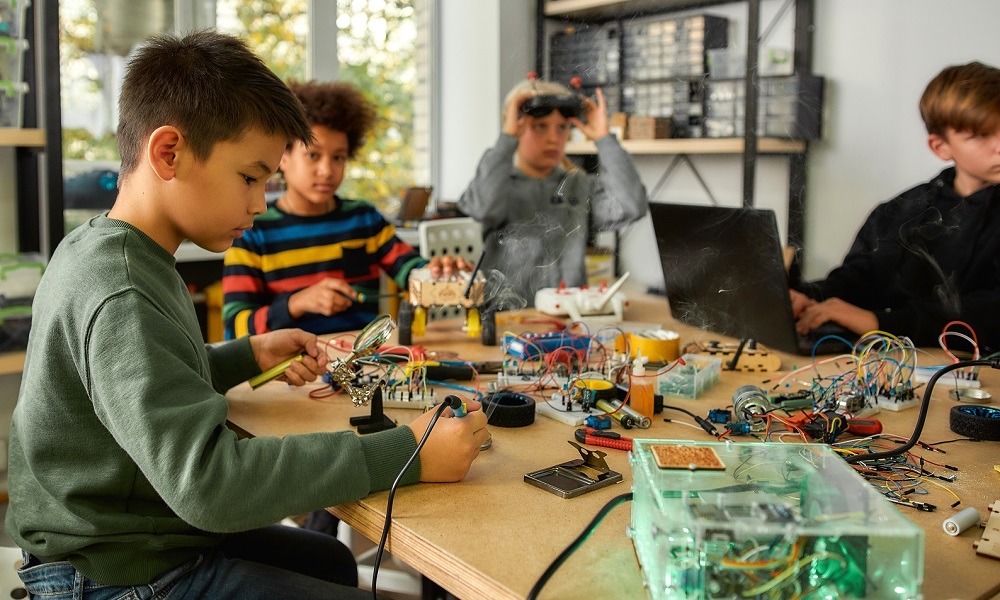STEM (Science, Technology, Engineering, and Mathematics) education is a dynamic and modern curriculum designed to provide children with the tools they need to thrive in a fast-paced, technology-driven world. Instead of teaching these subjects as separate disciplines, STEM integrates them into a cohesive learning experience that encourages hands-on exploration and creativity. This interdisciplinary approach ensures that students not only learn essential academic concepts but also understand how to apply them in real-world situations.
STEM education is a great way to cultivate critical thinking, problem-solving, and teamwork, helping children gain confidence in their abilities and develop a love for learning. In this blog, we’ll dive into the benefits of STEM education, who can benefit from it, and how it fosters a more engaging and effective learning environment for students.
What is STEM Education?
STEM is a curriculum focused on the integration of four core subjects: science, technology, engineering, and mathematics. It’s designed to engage students in hands-on learning activities that teach them how these subjects are connected. Instead of isolating each subject, STEM combines them to provide students with practical, real-world applications of what they learn in the classroom.
Students learn about geometry through 3D modeling, improve spelling and literacy through coding, and develop storytelling skills by designing games. This interdisciplinary approach allows children to see the relevance of what they are learning and how it applies to the world around them. It is both engaging and highly effective for students with a natural curiosity or passion for problem-solving and innovation.
Benefits of STEM Education
STEM education offers a wide range of benefits for students, especially those who thrive in creative, hands-on learning environments. Here are some of the most significant benefits of a STEM-based curriculum:
1. Making Math and Science Fun and Engaging
For many students, math and science can be intimidating subjects. STEM takes a fresh approach by turning these subjects into exciting, interactive learning experiences. Through activities like coding, robotics, and 3D design, students explore math and science in new ways that are both fun and educational. These activities inspire curiosity and creativity, making students more engaged in their learning and helping them develop a positive attitude toward these essential subjects.
2. Geometry in Action: 3D Modeling for Young Minds
STEM allows students to bring abstract concepts like geometry to life through 3D modeling. By using technology to create 3D models of objects, students gain a deeper understanding of spatial relationships, measurements, and shapes. This hands-on approach to geometry makes the subject more accessible and helps students develop problem-solving skills that they can apply across various disciplines.
3. Coding for Literacy: Spelling in the Digital Age
STEM education combines technology with language arts, allowing students to use coding to improve their spelling and literacy. By creating digital stories, games, and animations, students practice writing, spelling, and logic. This innovative approach to literacy makes learning more interactive and encourages students to think creatively about how they express themselves through both written and digital mediums.
4. Encouraging Teamwork and Collaboration
STEM projects often require teamwork, which fosters collaboration and communication skills. Whether working together to build a robot or solve a math problem, students learn how to work as part of a team, share ideas, and listen to others. These skills are essential for future success in both academic and professional environments.
5. Igniting Creativity Through Interdisciplinary Learning
STEM goes beyond rote memorization by encouraging students to explore their creativity. Through interdisciplinary learning, students combine their knowledge of science, technology, engineering, and math to solve real-world problems in innovative ways. This approach helps students develop critical thinking skills and promotes creativity, which are crucial in today’s rapidly changing world.
6. Cultivating a Love for Learning Through Play
One of the greatest strengths of STEM education is its ability to turn learning into a fun and engaging experience. By incorporating play into the curriculum, STEM fosters a love for learning that goes beyond the classroom. Students enjoy experimenting, building, and creating, which keeps them motivated to learn more. This love for learning can set the foundation for lifelong curiosity and intellectual growth.
Who Can Benefit from STEM Education?
STEM education is suitable for a wide range of students, from those with a natural interest in science and technology to those who may not traditionally excel in these areas. Here’s a look at the types of students who can benefit most from a STEM-based curriculum:
- Curious and Creative Learners: Students who love to explore new ideas and think outside the box will thrive in STEM’s hands-on, creative learning environment.
- Problem Solvers: STEM encourages critical thinking and problem-solving, making it ideal for students who enjoy tackling challenges and finding solutions.
- Future Innovators: Children interested in technology, engineering, or science-related careers will gain valuable skills and experience through STEM education.
- Collaborators: Students who enjoy working with others will benefit from the teamwork and collaborative projects that are an integral part of STEM learning.
- Reluctant Learners: STEM’s interactive and engaging approach to education can help reluctant learners discover a newfound passion for subjects they once found challenging or uninteresting.
Why Choose STEM for Your Child?
STEM education provides more than just academic knowledge—it equips students with the tools they need for success in the 21st century. The interdisciplinary nature of STEM helps children develop a well-rounded skill set, including critical thinking, collaboration, and creativity. By encouraging students to approach learning with curiosity and an open mind, STEM fosters intellectual growth and prepares them for the challenges of the future.
Whether your child is naturally inclined toward science and technology or needs a more engaging way to explore these subjects, STEM education provides the perfect environment for intellectual and personal growth.
Call to Action: Help Your Child Unlock Their Potential with STEM Education
Are you ready to give your child the opportunity to explore the exciting world of STEM? Our STEM curriculum is designed to inspire creativity, critical thinking, and collaboration while making learning fun and engaging. Contact us today to learn more about our STEM programs or to schedule a consultation. Let’s work together to help your child discover their full potential and ignite a lifelong love for learning.





